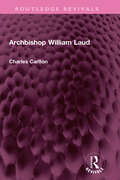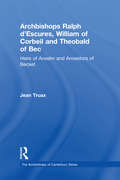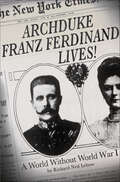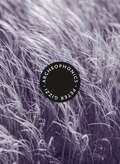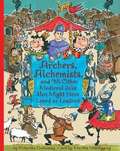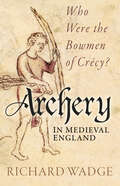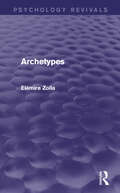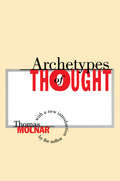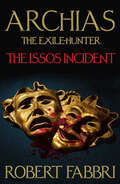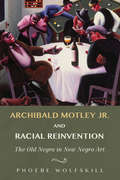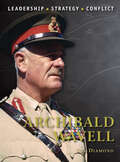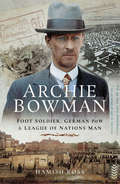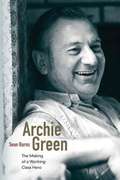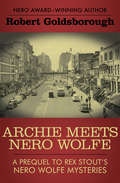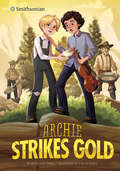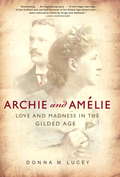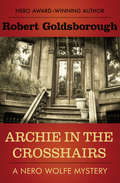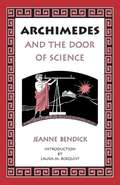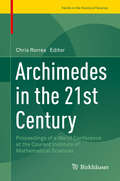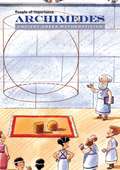- Table View
- List View
Archbishop William Laud (Routledge Revivals)
by Charles CarltonFirst published in 1987, Archbishop William Laud shows how Laud dragged the English Church, and with it English society, towards a new and radical version of Anglicanism. Carlton presents Laud in the context of his times, showing how closely his personal life and character were woven into his political and religious career. By using Laud’s personal papers, his letters and diary, Carlton draws a psychological profile of this most insecure man. He analyses Laud’s dreams, revealing that both awake and asleep the archbishop was haunted by some guilty secret, obsessed with details, bedevilled by enemies and conspiracies, while being both ashamed and proud of his own humble origins. The tensions between Laud’s private and public worlds made him seem cruel, thus turning him into the perfect scapegoat for the failure of the king’s policies. This book will be of interest to students of history, literature and psychology.
Archbishops Ralph d'Escures, William of Corbeil and Theobald of Bec: Heirs of Anselm and Ancestors of Becket (The Archbishops of Canterbury Series)
by Jean TruaxThe first two archbishops of Canterbury after the Norman Conquest, Lanfranc and Anselm, were towering figures in the medieval church and the sixth archbishop, the martyred Thomas Becket, is perhaps the most famous figure ever to hold the office. In between these giants of the ecclesiastical world came three less noteworthy men: Ralph d'Escures, William of Corbeil, and Theobald of Bec. Jean Truax's volume in the Ashgate Archbishops of Canterbury Series uniquely examines the pontificates of these three minor archbishops. Presenting their biographies, careers, thought and works as a unified period, Truax highlights crucial developments in the English church during the period of the pontificates of these three archbishops, from the death of Anselm to Becket. The resurgent power of the papacy, a changed relationship between church and state and the expansion of archiepiscopal scope and power ensured that in 1162 Becket faced a very different world from the one that Anselm had left in 1109. Selected correspondence, newly translated chronicle accounts and the text and a discussion of the Canterbury forgeries complete the volume.
Archduke Franz Ferdinand Lives!: A World Without World War I
by Richard Ned LebowArchduke Franz Ferdinand Lives! presents an intellectually invigorating set of hypotheticals about the twentieth century--had we been smart enough to avoid World War I.The "Great War" claimed nearly 40 million lives and set the stage for World War II, the Holocaust, and the Cold War. More than one hundred years later, historians are beginning to recognize how unnecessary it was. In Archduke Franz Ferdinand Lives!, acclaimed political psychologist Richard Ned Lebow examines the chain of events that led to war and what could reasonably have been done differently to avoid it. In this highly original and intellectually challenging book, he constructs plausible worlds, some better, some worse, that might have developed. He illustrates them with "what-if" biographies of politicians, scientists, religious leaders, artists, painters, and writers, sports figures, and celebrities, including scenarios where: there is no Israel; neither John Kennedy nor Barack Obama become president; Curt Flood, not Jackie Robinson, integrates baseball; Satchmo and many Black jazz musicians leave for Europe, where jazz blends with klezmer; nuclear research is internationalized and all major countries sign a treaty outlawing the development of atomic weapons; Britain and Germany are entrapped in a Cold War that threatens to go nuclear; and much more.
Archduke of Sarajevo
by Gordon Brook-ShepherdA biography of the ill-fated Franz-Ferdinand whose assassination in 1914 set in motion the train of events that led to World War One
Archeologies of Confession: Writing the German Reformation, 1517-2017 (Spektrum: Publications of the German Studies Association #16)
by David M. Luebke Jesse Spohnholz Carina L. Johnson Marjorie E. PlummerModern religious identities are rooted in collective memories that are constantly made and remade across generations. How do these mutations of memory distort our picture of historical change and the ways that historical actors perceive it? Can one give voice to those whom history has forgotten? The essays collected here examine the formation of religious identities during the Reformation in Germany through case studies of remembering and forgetting—instances in which patterns and practices of religious plurality were excised from historical memory. By tracing their ramifications through the centuries, Archeologies of Confession carefully reconstructs the often surprising histories of plurality that have otherwise been lost or obscured.
Archeophonics (Wesleyan Poetry Ser.)
by Peter GizziSoulful and intricate lyrics make this Gizzi's strongest book to dateArcheophonics is the first collection of new work from the poet Peter Gizzi in five years. Archeophonics, defined as the archeology of lost sound, is one way of understanding the role and the task of poetry: to recover the buried sounds and shapes of languages in the tradition of the art, and the multitude of private connections that lie undisclosed in one's emotional memory. The book takes seriously the opening epigraph by the late great James Schuyler: "poetry, like music, is not just song." It recognizes that the poem is not a decorative art object but a means of organizing the world, in the words of anthropologist Clifford Geertz, "into transient examples of shaped behavior." Archeophonics is a series of discrete poems that are linked by repeated phrases and words, and its themes and nothing less than joy, outrage, loss, transhistorical thought, and day-to-day life. It is a private book of public and civic concerns.
Archers, Alchemists, and 98 Other Medieval Jobs You Might Have Loved or Loathed
by Priscilla GallowayA fascinating guide to strange-but-true jobs. If you could go back in time to the Middle Ages, what do you think you would be? A bold knight? A Princess? A Cardinal? In reality, most people did jobs we can barely imagine today.
Archery in Medieval England: Who Were the Bowmen of Crécy?
by Richard WadgeHow was it that ordinary men in medieval England and Wales became such skilled archers that they defeated noble knights in battle after battle? The archer in medieval England became a forerunner of John Bull as a symbol of the spirit of the ordinary Englishman. He had his own popular literature that left us a romantic version of the lives and activities of outlaws and poachers such as Robin Hood.This remarkable development began 150 years after the traumatic events of the Norman Conquest transformed the English way of life, in ways that were almost never to the benefit of the English. This book is the first account of the way ordinary men used bows and arrows in their day-to-day lives, and the way that their skills became recognised by the kings of England as invaluable in warfare.
Archetypes (Psychology Revivals)
by Elémire ZollaMan is dominated by his archetypes; they mould not only his history but his dreams. But how are we to define and evaluate them? Is it perhaps possible for us to relate more creatively to them? Originally published in 1981, these are some of the questions raised by this title. To answer them the author gathered together a vast amount of material drawn from Eastern and Western traditions, from science, literature, art and poetry. The answers he puts forward are often highly original and will surely challenge many of our most cherished patterns of thought. There emerges from this book what can only be described as a global metaphysical system, yet the author’s language is not that of an ordinary metaphysical treatise, and what he writes offered new challenge and hope to those suffering from the despair and cynicism engendered by a great deal in modern society at the time. Zolla does not, however, advocate a return to earlier historical patterns, nor is he proposing a new Utopia, but rather offers us a brilliant series of lessons in the art of centring. In the words of Bernard Wall, writing in the Times Literary Supplement, Zolla’s ‘deep, polymathic probing of the terms of human existence makes it sensible to compare him with Simone Weil, while some of his conclusions about ultimate mysteries – expressed in signs, symbols and sacraments, the sense of which we have lost – will make us think of the later T. S. Eliot’.
Archetypes of Thought
by Thomas MolnarIn Archetypes of Thought, originally published in 1991 with the title Philosophical Grounds, Thomas Molnar follows seven basic themes of Western philosophical speculation from their development in the earliest times of systematic thought through their evolution through the centuries and civilizations to the present. Some of the themes are origin and its reflection, guilt of being, one and the multiple, the temptation of mechanization, and nocturnal man. The book is neither a chronological treatment of issues nor a list of philosophical schools and movements. Rather, it reaches for the archetypes of philosophical reasoning. Molnar shows the presence of modern themes in the entire history of thinking, traces technology to the first stirrings of rationalism, and evinces modern man's feeling of culpability. Throughout, the soul is perceived as the keeper of God's and man's secret, one which reflects reality and also tries to organize it according to an ontologically implanted rhythm. In his new introduction, Molnar explains and re-examines his reasons for writing the book. While the themes he covers have been widely dealt with in contemporary thought, they are brought together to form an original combination of philosophical concepts. Archetypes of Thought is an intriguing study of the evolution of philosophical thinking. It is essential reading for both students and professionals of philosophy, history, and sociology.
Archias the Exile-Hunter: An Alexander's Legacy Novella (Alexander’s Legacy)
by Robert FabbriAn Archias the Exile-Hunter short storyArchias, struggling actor, quick on his feet and even faster with his words, is at the end of his luck. Having escaped to Rhosos, on the edge of Macedon's territory, to evade the threat of the debt collectors, he has been prevented from going any further by the arrival of Alexander the Great's mighty army. And with it, those very same debt collectors.So when the chance is given to him to earn enough money to be rid of his pursuers forever, he has to take it. Even if it means risking life and limb by attempting the most crazy of rescues - to bring back a kidnapped boy from inside the camp of Darius, King of Kings of the crumbling Persian empire. A camp that is on the eve of battle... As Alexander's troops draw nearer, and Darius's cavalry begin their war-cry, can Archias save himself, the boy, and his fellow rescuers, before it's too late?
Archibald Motley Jr. and Racial Reinvention: The Old Negro in New Negro Art
by Phoebe WolfskillAn essential African American artist of his era, Archibald Motley Jr. created paintings of black Chicago that aligned him with the revisionist aims of the New Negro Renaissance. Yet Motley's approach to constructing a New Negro--a dignified figure both accomplished and worthy of respect--reflected the challenges faced by African American artists working on the project of racial reinvention and uplift. Phoebe Wolfskill demonstrates how Motley's art embodied the tenuous nature of the Black Renaissance and the wide range of ideas that structured it. Focusing on key works in Motley's oeuvre, Wolfskill reveals the artist's complexity and the variety of influences that informed his work. Motley's paintings suggest that the racist, problematic image of the Old Negro was not a relic of the past but an influence that pervaded the Black Renaissance. Exploring Motley in relation to works by notable black and non-black contemporaries, Wolfskill reinterprets Motley's oeuvre as part of a broad effort to define American cultural identity through race, class, gender, religion, and regional affiliation.
Archibald Wavell
by Peter Dennis Jon DiamondArchibald Wavell remains one of the great Allied commanders of the early phases of World War II. In fact, between June 1940 and June 1941, he was the only British theatre commander actively engaging Axis forces. At a time when the British Expeditionary Force had been expelled from the European continent and the home isles were preparing as best they could for the threat of a Nazi invasion, Wavell was conducting campaigns across nine countries and parts of two continents. In those 12 months, Wavell planned and directly oversaw a multitude of campaigns, from the hugely successful winter campaigns against the Italians in the Western Desert and the conquest of Italian East Africa, through the Iraqi revolt, the invasion of Vichy Syria and Lebanon and the ill-fated British involvement in Greece to the unsuccessful attempts to break the siege of Tobruk that led to his replacement in June 1941. He then took command of all Allied forces in the Burma theatre, leading the desperate and doomed defence against the Japanese offensive. While Wavell's great victories are often overshadowed by those of other commanders later in the war, this should not detract from his proven abilities as a strategist and tactician. This book tells the complete story of Wavell's wartime exploits and examines his strengths and weaknesses as a commander.
Archie Bowman: Foot Soldier, German POW and League of Nations Man
by Hamish RossIn 1915, Archie Bowman, a philosophy professor at Princeton, was granted leave of absence to join the British army. He served in the HLI and was captured at the Battle of the Lys.Prison camp, though, turned out not to be the living death he expected: he was fluent in German and became the main go-between with camp authorities and British prisoners; he gave talks to hundreds of prisoners, and wrote up in verse form his account of the battle and his capture and two-day march into captivity. When he was transferred to another camp, his writings were confiscated; but in his new camp his responsibilities increased, and he became key negotiator and formed a bond with the Commandant, a fellow academic, who secured the release of his confiscated work, which, when completed, was published as prison camp verses.After the Armistice, he was posted to the British Army of the Rhine in Cologne, where he found his most interesting work in the service, interviewing German civilians wishing to travel into another Occupied Zone.Although Bowman didnt become a pacifist he was convinced more could be done to prevent wars; and he dedicated himself to the cause of peace and championed the ideal of the League of Nations, at the cost of his health.Based on the archived Bowman Papers, it is a fascinating story of a man of high principle and great depth of feeling who had the love and support of his wife Mabel.
Archie Ferguson: Alaska's Clown Prince and “Craziest Pilot in the World”
by Steve LeviArchie Ferguson is the last of the original fly-by-the-seat-of-your-pants Alaska bush pilots to be the subject of a biography. Dubbed Alaska's Clown Prince," he added many hilarious chapters to Alaska's history. He is also the originator of the "Arctic Bump," current practice of airline pilots who give a blast of power as they fly over the Arctic Circle to provide gullible tourists the impression that the air north of the Arctic Circle is different than air south of the Arctic Circle. His title, "the Craziest Pilot in the World, was given to him by The Saturday Evening Post in its December 1945 issue. Ferguson, who died in 1967, was an excellent example of the colorful character/con men who made Alaska what it is today."
Archie Green: The Making of a Working-Class Hero
by David Roediger Nick Spitzer Sean BurnsArchie Green: The Making of a Working-Class Hero celebrates one of the most revered folklorists and labor historians of the twentieth century. Devoted to understanding the diverse cultural customs of working people, Archie Green (1917-2009) tirelessly documented these traditions and educated the public about the place of workers' culture and music in American life. Doggedly lobbying Congress for support of the American Folklife Preservation Act of 1976, Green helped establish the American Folklife Center at the Library of Congress, a significant collection of images, recordings, and written accounts that preserve the myriad cultural productions of Americans. Capturing the many dimensions of Green's remarkably influential life and work, Sean Burns draws on extensive interviews with Green and his many collaborators to examine the intersections of radicalism, folklore, labor history, and worker culture with Green's work. Burns closely analyzes Green's political genealogy and activist trajectory while illustrating how he worked to open up an independent political space on the American Left that was defined by an unwavering commitment to cultural pluralism.
Archie Meets Nero Wolfe: A Prequel to Rex Stout's Nero Wolfe Mysteries (The Nero Wolfe Mysteries #8)
by Robert GoldsboroughAn &“excellent&” novel that goes back to 1920s New York to reveal how the famed detective first met his incomparable sidekick (Publishers Weekly, starred review). In 1930, young Archie Goodwin comes to New York City hoping for a bit of excitement. In his third week working as a night watchman, he stops two burglars in their tracks—with a pair of hot lead slugs. Dismissed from his job for being &“trigger-happy,&” he parlays his newfound notoriety into a job as a detective&’s assistant, helping honest sleuth Del Bascom solve cases like the Morningside Piano Heist, the Rive Gauche Art Gallery Swindle, and the Sumner-Hayes Burglary. But it&’s the kidnapping of Tommie Williamson, the son of a New York hotel magnate, that introduces Goodwin to the man who will change his life. Goodwin knows there&’s only one detective who can help find Tommie: Nero Wolfe, the stout genius of West Thirty-Fifth Street. Together, they&’ll form one of the most unlikely crime fighting duos in history—but first Goodwin must locate Tommie and prove that he deserves a place by Wolfe&’s side. In this witty story about the origin of a legendary partnership, Robert Goldsborough gloriously evokes the spirit of Nero Wolfe&’s creator, bestselling author Rex Stout, and breathes new life into his beloved characters.
Archie Meets Nero Wolfe: A Prequel to Rex Stout's Nero Wolfe Mysteries (The Nero Wolfe Mysteries #8)
by Robert GoldsboroughAn &“excellent&” novel that goes back to 1920s New York to reveal how the famed detective first met his incomparable sidekick (Publishers Weekly, starred review). In 1930, young Archie Goodwin comes to New York City hoping for a bit of excitement. In his third week working as a night watchman, he stops two burglars in their tracks—with a pair of hot lead slugs. Dismissed from his job for being &“trigger-happy,&” he parlays his newfound notoriety into a job as a detective&’s assistant, helping honest sleuth Del Bascom solve cases like the Morningside Piano Heist, the Rive Gauche Art Gallery Swindle, and the Sumner-Hayes Burglary. But it&’s the kidnapping of Tommie Williamson, the son of a New York hotel magnate, that introduces Goodwin to the man who will change his life. Goodwin knows there&’s only one detective who can help find Tommie: Nero Wolfe, the stout genius of West Thirty-Fifth Street. Together, they&’ll form one of the most unlikely crime fighting duos in history—but first Goodwin must locate Tommie and prove that he deserves a place by Wolfe&’s side. In this witty story about the origin of a legendary partnership, Robert Goldsborough gloriously evokes the spirit of Nero Wolfe&’s creator, bestselling author Rex Stout, and breathes new life into his beloved characters.
Archie Strikes Gold (Smithsonian Historical Fiction)
by Brandon TerrellArchie is traveling with his uncle Harold, a member of an entertainment revue hired by the renovated Dawson City Theatre, to perform for the Yukon gold rushers. While there, Harold befriends an older gentleman, Montgomery Wycroft, who is in the area panning for gold. Archie and his uncle opt to stay behind in Dawson City, joining Monty on his dangerous quest for gold, battling with both greedy gold-seekers and the unforgiving Canadian terrain. Will Archie and his uncle strike gold, or will they find something more valuable?
Archie and Amelie: Love and Madness in the Gilded Age
by Donna M. LuceyFilled with glamour, mystery, and madness, Archie and Amélie is the true story chronicling a tumultuous love affair in the Gilded Age. John Armstrong "Archie" Chanler was an heir to the Astor fortune, an eccentric, dashing, and handsome millionaire. Amélie Rives, Southern belle and the goddaughter of Robert E. Lee, was a daring author, a stunning temptress, and a woman ahead of her time. Archie and Amélie seemed made for each other—both were passionate, intense, and driven by emotion—but the very things that brought them together would soon tear them apart. Their marriage began with a “secret” wedding that found its way onto the front page of the New York Times, to the dismay of Archie’s relatives and Amélie’s many gentleman friends. To the world, the couple appeared charmed, rich, and famous; they moved in social circles that included Oscar Wilde, Teddy Roosevelt, and Stanford White. But although their love was undeniable, they tormented each other, and their private life was troubled from the start. They were the F. Scott and Zelda Fitzgerald of their day—a celebrated couple too dramatic and unconventional to last—but their tumultuous story has largely been forgotten. Now, Donna M. Lucey vividly brings to life these extraordinary lovers and their sweeping, tragic romance. “In the Virginia hunt country just outside of Charlottesville, where I live, the older people still tell stories of a strange couple who died some two generations ago. The stories involve ghosts, the mysterious burning of a church, a murder at a millionaire’s house, a sensational lunacy trial, and a beautiful, scantily clad young woman prowling her gardens at night as if she were searching for something or someone—or trying to walk off the effects of the morphine that was deranging her. I was inclined to dismiss all of this as tall tales Virginians love to spin out; but when I looked into these yarns I found proof that they were true. . . .” —Donna M. Lucey on Archie and Amélie
Archie and Amelie: Love and Madness in the Gilded Age
by Donna M. LuceyFilled with glamour, mystery, and madness, Archie and Amélie is the true story chronicling a tumultuous love affair in the Gilded Age. John Armstrong "Archie" Chanler was an heir to the Astor fortune, an eccentric, dashing, and handsome millionaire. Amélie Rives, Southern belle and the goddaughter of Robert E. Lee, was a daring author, a stunning temptress, and a woman ahead of her time. Archie and Amélie seemed made for each other—both were passionate, intense, and driven by emotion—but the very things that brought them together would soon tear them apart. Their marriage began with a “secret” wedding that found its way onto the front page of the New York Times, to the dismay of Archie’s relatives and Amélie’s many gentleman friends. To the world, the couple appeared charmed, rich, and famous; they moved in social circles that included Oscar Wilde, Teddy Roosevelt, and Stanford White. But although their love was undeniable, they tormented each other, and their private life was troubled from the start. They were the F. Scott and Zelda Fitzgerald of their day—a celebrated couple too dramatic and unconventional to last—but their tumultuous story has largely been forgotten. Now, Donna M. Lucey vividly brings to life these extraordinary lovers and their sweeping, tragic romance. “In the Virginia hunt country just outside of Charlottesville, where I live, the older people still tell stories of a strange couple who died some two generations ago. The stories involve ghosts, the mysterious burning of a church, a murder at a millionaire’s house, a sensational lunacy trial, and a beautiful, scantily clad young woman prowling her gardens at night as if she were searching for something or someone—or trying to walk off the effects of the morphine that was deranging her. I was inclined to dismiss all of this as tall tales Virginians love to spin out; but when I looked into these yarns I found proof that they were true. . . .” —Donna M. Lucey on Archie and Amélie
Archie in the Crosshairs: A Nero Wolfe Mystery (The Nero Wolfe Mysteries #10)
by Robert GoldsboroughMystery fans will devour this entry into the classic, wisecracking Nero Wolfe series, in which Wolfe must track down a dangerous gunman—or risk losing his right-hand man Archie Goodwin is chipper as he strolls home from his weekly poker game, money in his pocket and a smile on his lips. He has just reached Nero Wolfe&’s stately brownstone on West Thirty-Fifth Street when a sedan whips around the corner and two gunshots ring out, nearly hitting Goodwin. It is a warning, and the message is clear: The next bullet will not miss. Rotund investigator Nero Wolfe has made more than his fair share of enemies over the years, and it seems one of them has decided to strike, targeting Wolfe&’s indefatigable assistant. Some might run for cover, but Archie Goodwin is not the type. With the help of Wolfe&’s brainpower, Goodwin will find the man who wants him dead—unless the killer gets to Goodwin first. Nero Award–winning author Robert Goldsborough continues the brilliant work of Rex Stout in this classic mystery series. According to Publishers Weekly, &“Goldsborough cleverly captures the tone and language of the originals. Rex Stout fans can only hope he has no plans to wind up the series soon.&”
Archimedes and the Door of Science
by Jeanne BendickJeanne Bendick, through text and pictures, admirably succeeds in bringing to life the ancient Greek mathematician who enriched mathematics and all branches of science. Against the backdrop of Archimedes' life and culture, the author discusses the man's work, his discoveries and the knowledge later based upon it. The simple, often humorous, illustrations and diagrams greatly enhance the text.
Archimedes in the 21st Century: Proceedings of a World Conference at the Courant Institute of Mathematical Sciences (Trends in the History of Science)
by Chris RorresThis book is a collection of papers presented at the "Archimedes in the 21st Century" world conference, held at the Courant Institute of Mathematical Sciences in 2013. This conference focused on the enduring and continuing influence of Archimedes in our modern world, celebrating his centuries of influence on mathematics, science, and engineering. Archimedes planted the seeds for a myriad of seminal ideas that would grow over the ages. Each chapter surveys the growth of one or more of these seeds, and the fruit that they continue to bear to this day. The conference speakers contributing to this book are actively involved in STEM fields whose origins trace back to Archimedes, many of whom have conducted and published research that extends Archimedes' work into the 21st century. The speakers are not historians, so while historical context is provided, this book is uniquely focused on the works themselves as opposed to their history. The breadth and depth of Archimedes' influence will inspire, delight, and even surprise readers from a variety of fields and interests including historians, mathematicians, scientists, and engineers. Only a modest background in math is required to read this book, making it accessible to curious readers of all ages.
Archimedes: Ancient Greek Mathematician
by Susan KeatingModern life would be very different without the ideas of brilliant Greek scholar Archimedes. From the simple lever to complicated machines, his work in mathematics, physics, engineering, and astronomy helped to shape the world we live in today. Few thinkers of any time period have had as big an impact on math and science as the genius Archimedes. Learn the story of one of the most important mathematic thinkers of all time in Archimedes: Ancient Greek Mathematician.
